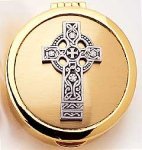Sacred Vessels, Part 2: Pyx

The Pyx is perhaps the sacred vessel that has changed the most in ecclesiastical history. It is a very useful device, and would have come in handy to St. Tarcisius. It is also the only sacred vessel that is not presently used in the liturgy (the monstrance isn't used routinely in the mass, but shows up at things like First Friday celebrations). So its existence sometimes comes as a surprise to people who are less familiar with the practices of the faith. When I first explained the pyx to Layla, she summarized its purpose as "Jesus in your pocket." And, in its modern usage, this is more or less correct.
In ages past, the term applied generally to all vessels used to hold the Blessed Sacrament. Before the rise of modern-style tabernacles in the renaissance, pyx was often the name given to the vessel of reservation. These were either small boxes made in the shape of a church, or other variously-shaped vessels suspended from the ceiling of the church above the altar. Thereafter, pyxes were not used for reservation principally, but continued to be quite box-like in construction. Some of these moved more towards today's minimalistic pyx, while others, known as pyx pediculata, continued to be supported by a pedastal. These more elaborate pyxes were sometimes used to hold the Blessed Sacrament inside the tabernacle, rather than a ciborium.
Once the pyx no longer served as the primary locus of reservation, it came to acquire its common modern role of being used to transport the Eucharist to the sick. Its service in that role has fueled its simplification into a small round container several inches in diameter and often no more than a half inch in height. Formerly it was carried in a small pouch worn about the priest's neck and wrapped in a corporal. Today, the pyx-bag is seen far less often, and the vessel is often carried, albeit reverently, in a pocket. This change has also been precipitated by the pyx's frequent use by lay eucharistic ministers, and allows them to carry the Blessed Sacrament more discretely (once again, see St. Tarcisius). Thus, the pyx is, I would imagine exclusively, the only sacred vessel owned by a lay person for use.
Like other sacred vessels, the pyx is traditionally made of gold or another valuable metal gilded on the inside, although in the middle ages ivory pyxes were common. The GIRM currently permits the pyx, like other sacred vessels, to be made of other materials, as long as they are "prized in the region" and "suited to sacred use."
File Under: Sacred_Vessels








0 Comments:
Post a Comment
<< Home